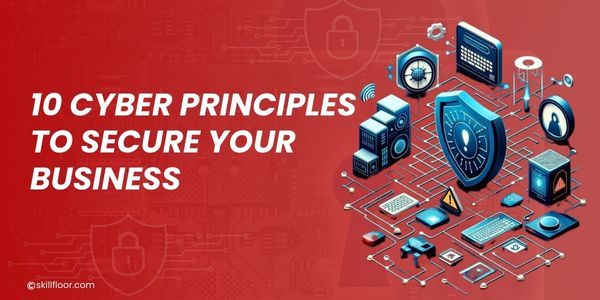Cybersecurity Tools List: Safeguarding Your Digital World
Discover the future of data science and explore a comprehensive list of cybersecurity tools that ensure the protection of your digital world.

In today's digital age, cybersecurity has become a top priority for individuals and organizations alike. With the increasing threat of cyber attacks, it is essential to have the right tools in place to protect sensitive information and secure digital assets. In this blog, we will explore a comprehensive list of cybersecurity tools that can help fortify your defenses against cyber threats. From network security to data encryption and threat intelligence, these tools offer a wide range of capabilities to safeguard your digital world. So, let's dive in and discover the essential cybersecurity tools you should consider.
Firewall
A firewall is the first line of defense against unauthorized access and malicious activities. It acts as a barrier between your internal network and external networks, monitoring incoming and outgoing traffic. Firewalls can be hardware-based or software-based and provide features like packet filtering, application-level filtering, and intrusion detection. By enforcing access controls and blocking suspicious traffic, firewalls play a crucial role in protecting your network from unauthorized access and potential threats.
Antivirus Software
Antivirus software is designed to detect, prevent, and remove malicious software, such as viruses, worms, and Trojans. It scans files, emails, and web pages for known malware signatures and behavior patterns, providing real-time protection against threats. With regular updates and scans, antivirus software helps keep your devices and data safe from malware infections and other cyber threats.
Intrusion Detection System (IDS) and Intrusion Prevention System (IPS)
IDS and IPS are security tools that monitor network traffic and detect any unauthorized activity or potential security breaches. IDS analyzes network traffic patterns and alerts administrators about suspicious behavior, while IPS goes a step further by actively blocking and preventing such activities. These tools provide real-time monitoring and analysis, helping to identify and respond to security incidents promptly.
Virtual Private Network (VPN)
A VPN establishes a secure, encrypted connection between your device and a remote server, allowing you to browse the internet anonymously and securely. It creates a private tunnel through which your data travels, protecting it from eavesdropping and unauthorized access. VPNs are particularly useful when accessing public Wi-Fi networks or when you need to mask your IP address and location.
Data Encryption Tools
Data encryption tools secure your sensitive information by converting it into unreadable code that can only be deciphered with the proper decryption key. Encryption protects data in transit and at rest, ensuring that even if it falls into the wrong hands, it remains inaccessible. Tools like encryption software and hardware modules provide strong encryption algorithms, giving you peace of mind that your data is safe from unauthorized access.
Vulnerability Assessment Tools
Vulnerability assessment tools scan your systems, applications, and networks to identify potential vulnerabilities and weaknesses that could be exploited by attackers. These tools help you understand the security posture of your environment, allowing you to prioritize and address vulnerabilities proactively. By conducting regular vulnerability assessments, you can stay ahead of threats and ensure that your systems are adequately protected.
Security Information and Event Management (SIEM)
SIEM tools collect and analyze security event logs from various sources, such as firewalls, IDS/IPS, and antivirus systems. They provide real-time monitoring, correlation, and analysis of security events, enabling early detection and response to security incidents. SIEM tools also offer features like log management, incident response automation, and compliance reporting, making them essential for effective cybersecurity management.
Web Application Firewall (WAF)
A web application firewall protects web applications from common security threats, such as SQL injection, cross-site scripting (XSS), and distributed denial-of-service (DDoS) attacks. It filters and monitors incoming web traffic, analyzing requests and responses to detect and block malicious activities. WAFs help ensure the security and availability of web applications, safeguarding against potential vulnerabilities and unauthorized access.
Password Managers
Password managers help you create and manage strong, unique passwords for different online accounts. They securely store your passwords and automatically fill them in when needed, reducing the risk of using weak or reused passwords. By promoting good password hygiene, password managers enhance your overall security posture and minimize the chances of unauthorized access to your accounts.
Network Monitoring and Traffic Analysis Tools
Network monitoring and traffic analysis tools help you monitor and analyze network activity, providing visibility into data flows, bandwidth usage, and potential security threats. These tools enable you to detect anomalies, identify suspicious patterns, and investigate network incidents. By continuously monitoring your network, you can proactively identify and address any security vulnerabilities or abnormal behavior, ensuring the integrity and availability of your network resources.
Endpoint Protection Software
Endpoint protection software is designed to secure individual devices, such as laptops, desktops, and mobile devices, from malware, unauthorized access, and other security threats. It includes features like antivirus, firewall, and intrusion prevention, providing comprehensive protection for endpoints. With the increasing number of remote work setups, securing endpoints has become more critical than ever. Endpoint protection software ensures that devices accessing your network are secure and compliant with your organization's security policies
Incident Response Tools
Incident response tools assist in managing and responding to cybersecurity incidents effectively. These tools streamline the incident response process by providing centralized incident tracking, communication, and documentation. They facilitate quick identification, containment, eradication, and recovery from security incidents, minimizing the impact on your systems and data. Incident response tools help coordinate efforts across teams, ensuring a timely and efficient response to security incidents.
Data Loss Prevention (DLP) Solutions
Data Loss Prevention solutions help prevent the unauthorized disclosure or leakage of sensitive data. They monitor and control data in motion, at rest, and in use, enforcing security policies and preventing data breaches. DLP solutions offer features like content inspection, data classification, encryption, and user activity monitoring. By identifying and mitigating data leakage risks, DLP solutions play a vital role in protecting confidential information and ensuring regulatory compliance.
In a Nutshell, The field of cybersecurity offers a wide array of tools designed to protect individuals and organizations from malicious threats and cyber attacks. The cyber security tools discussed in this blog provide a solid foundation for defending against a variety of risks and vulnerabilities. From firewalls and antivirus software to encryption tools and incident response platforms, these tools address different aspects of cybersecurity, including network protection, data security, threat detection, and user awareness.
However, it's important to remember that cybersecurity is a continuous effort, and no single tool can provide complete security on its own. A holistic approach that combines the right tools with regular updates, proactive monitoring, and user education is crucial for maintaining a strong defense against evolving threats. By leveraging the power of these cybersecurity tools and adopting best practices, individuals and organizations can enhance their security posture and safeguard their digital assets. Stay informed, stay vigilant, and prioritize cybersecurity in an ever-changing digital landscape.





























































